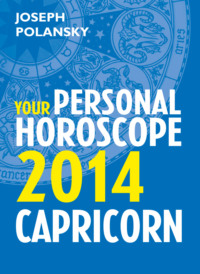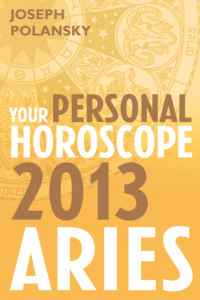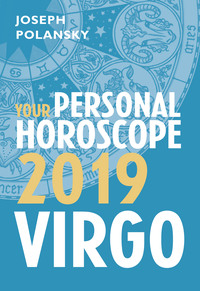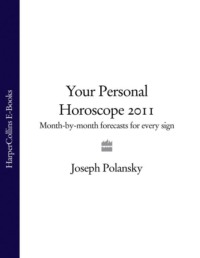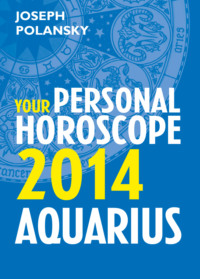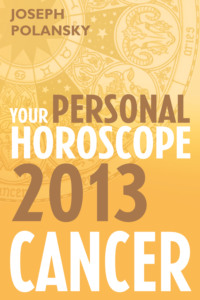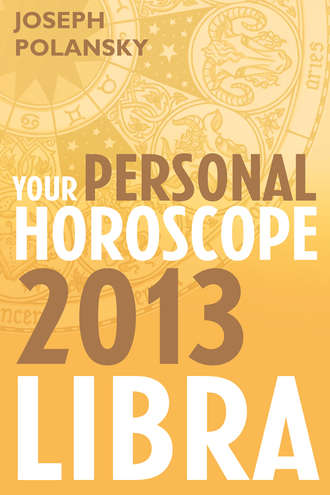
Полная версия
Libra 2013: Your Personal Horoscope

Joseph Polansky
Libra 2013
Your Personal Horoscope

Contents
Cover
Title Page
Introduction
Glossary of Astrological Terms
Libra
Personality Profile
Understanding a Libra
Horoscope for 2013
Month-by-month Forecasts
Copyright
About the Publisher
Introduction
Welcome to the fascinating and intricate world of astrology!
For thousands of years the movements of the planets and other heavenly bodies have intrigued the best minds of every generation. Life holds no greater challenge or joy than this: knowledge of ourselves and the universe we live in. Astrology is one of the keys to this knowledge.
This personal horoscope is designed to give you the fruits of astrological wisdom. In addition to general guidance on your character and the basic trends of your life, it shows you how to take advantage of planetary influences so you can make the most of the year ahead.
This book includes a Personality Profile, a look at general trends for 2013, and an in-depth month-by-month forecast for your sign. The Glossary explains some of the astrological terms you may be unfamiliar with.
One of the many helpful features is the ‘Best’ and ‘Most Stressful’ days listed at the beginning of each monthly forecast. Read these sections to learn which days in each month will be good overall, good for money, and good for love. Mark them on your calendar – these will be your best days. Similarly, make a note of the days that will be most stressful for you. It is best to avoid booking important meetings or taking major decisions on these days, as well as on those days when important planets in your horoscope are retrograde (moving backwards through the zodiac).
The Major Trends section for your sign lists those days when your vitality is strong or weak, or when relationships with your co-workers or loved ones may need a bit more effort on your part. If you are going through a difficult time, take a look at the colour, metal, gem and scent listed in the ‘At a Glance’ section of your Personality Profile. Wearing a piece of jewellery that contains your metal and/or gem will strengthen your vitality, just as wearing clothes or decorating your room or office in the colour ruled by your sign, drinking teas made from the herbs ruled by your sign or wearing the scents associated with your sign will sustain you.
In this edition we have included a foot reflexology chart as part of the health section. So many health problems could perhaps be avoided or alleviated if we understood which organs were most vulnerable and what we could do to protect them. Though there are many natural and drug-free ways to strengthen vulnerable organs, this chart shows a valid way to proceed. The vulnerable organs for the year ahead are clearly marked in the chart. It’s very good to massage the whole foot on a regular basis, as the feet contain reflexes to the entire body. Try to pay special attention to the specific areas marked in the chart. If this is done diligently, health problems can be avoided. And even if they can’t be completely avoided, their impact can be softened considerably.
I consider you – the reader – my personal client. By studying your Solar Horoscope I gain an awareness of what is going on in your life – what you are feeling and striving for and the challenges you face. I then do my best to address these concerns. Consider this book the next best thing to having your own personal astrologer!
It is my sincere hope that this horoscope will enhance the quality of your life, make things easier, illuminate the way forward, banish obscurities and make you more aware of your personal connection to the universe. Understood properly and used wisely, astrology is a great guide to knowing yourself, the people around you and the events in your life – but remember that what you do with these insights – the final result – is up to you.
Glossary of Astrological Terms
Ascendant
We experience day and night because the Earth rotates on its axis once every 24 hours. It is because of this rotation that the Sun, Moon and planets seem to rise and set. The zodiac is a fixed belt (imaginary, but very real in spiritual terms) around the Earth. As the Earth rotates, the different signs of the zodiac seem to the observer to rise on the horizon. During a 24-hour period every sign of the zodiac will pass this horizon point at some time or another. The sign that is at the horizon point at any given time is called the Ascendant, or rising sign. The Ascendant is the sign denoting a person’s self-image, body and self-concept – the personal ego, as opposed to the spiritual ego indicated by a person’s Sun sign.
Aspects
Aspects are the angular relationships between planets, the way in which one planet stimulates or influences another. If a planet makes a harmonious aspect (connection) to another, it tends to stimulate that planet in a positive and helpful way. If it makes a stressful aspect to another planet, this disrupts the planet’s normal influence.
Astrological Qualities
There are three astrological qualities: cardinal, fixed and mutable. Each of the 12 signs of the zodiac falls into one of these three categories.
Cardinal Signs
Aries, Cancer, Libra and Capricorn. The cardinal quality is the active, initiating principle. Those born under these four signs are good at starting new projects.
Fixed Signs
Taurus, Leo, Scorpio and Aquarius. Fixed qualities include stability, persistence, endurance and perfectionism. People born under these four signs are good at seeing things through.
Mutable Signs
Gemini, Virgo, Sagittarius and Pisces. Mutable qualities are adaptability, changeability and balance. Those born under these four signs are creative, if not always practical.
Direct Motion
When the planets move forward through the zodiac – as they normally do – they are said to be going ‘direct’.
Grand Square
A Grand Square differs from a normal Square (usually two planets separated by 90 degrees) in that four or more planets are involved. When you look at the pattern in a chart you will see a whole and complete square. This, though stressful, usually denotes a new manifestation in the life. There is much work and balancing involved in the manifestation.
Grand Trine
A Grand Trine differs from a normal Trine (where two planets are 120 degrees apart) in that three or more planets are involved. When you look at this pattern in a chart, it takes the form of a complete triangle – a Grand Trine. Usually (but not always) it occurs in one of the four elements: Fire, Earth, Air or Water. Thus the particular element in which it occurs will be highlighted. A Grand Trine in Water is not the same as a Grand Trine in Air or Fire, etc. This is a very fortunate and happy aspect, and quite rare.
Houses
There are 12 signs of the zodiac and 12 houses of experience. The 12 signs are personality types and ways in which a given planet expresses itself; the 12 houses show ‘where’ in your life this expression takes place. Each house has a different area of interest. A house can become potent and important – a House of Power – in different ways: if it contains the Sun, the Moon or the ‘ruler’ of your chart; if it contains more than one planet; or if the ruler of that house is receiving unusual stimulation from other planets.
1st House: Personal Image and Sensual Delights
2nd House: Money/Finance
3rd House: Communication and Intellectual Interests
4th House: Home and Family
5th House: Children, Fun, Games, Creativity, Speculations and Love Affairs
6th House: Health and Work
7th House: Love, Marriage and Social Activities
8th House: Transformation and Regeneration
9th House: Religion, Foreign Travel, Higher Education and Philosophy
10th House: Career
11th House: Friends, Group Activities and Fondest Wishes
12th House: Spirituality
Karma
Karma is the law of cause and effect which governs all phenomena. We are all where we find ourselves because of karma – because of actions we have performed in the past. The universe is such a balanced instrument that any act immediately sets corrective forces into motion – karma.
Long-term Planets
The planets that take a long time to move through a sign show the long-term trends in a given area of life. They are important for forecasting the prolonged view of things. Because these planets stay in one sign for so long, there are periods in the year when the faster-moving (short-term) planets will join them, further activating and enhancing the importance of a given house.
Jupiter: stays in a sign for about 1 year
Saturn: 2½ years
Uranus: 7 years
Neptune: 14 years
Pluto: 15 to 30 years
Lunar
Relating to the Moon. See also ‘Phases of the Moon’, below.
Natal
Literally means ‘birth’. In astrology this term is used to distinguish between planetary positions that occurred at the time of a person’s birth (natal) and those that are current (transiting). For example, Natal Sun refers to where the Sun was when you were born; transiting Sun refers to where the Sun’s position is currently at any given moment – which usually doesn’t coincide with your birth, or Natal, Sun.
Out of Bounds
The planets move through the zodiac at various angles relative to the celestial equator (if you were to draw an imaginary extension of the Earth’s equator out into the universe, you would have an illustration of this celestial equator). The Sun – being the most dominant and powerful influence in the Solar system – is the measure astrologers use as a standard. The Sun never goes more than approximately 23 degrees north or south of the celestial equator. At the winter solstice the Sun reaches its maximum southern angle of orbit (declination); at the summer solstice it reaches its maximum northern angle. Any time a planet exceeds this Solar boundary – and occasionally planets do – it is said to be ‘out of bounds’. This means that the planet exceeds or trespasses into strange territory – beyond the limits allowed by the Sun, the Ruler of the Solar system. The planet in this condition becomes more emphasized and exceeds its authority, becoming an important influence in the forecast.
Phases of the Moon
After the full Moon, the Moon seems to shrink in size (as perceived from the Earth), gradually growing smaller until it is virtually invisible to the naked eye – at the time of the next new Moon. This is called the waning Moon phase, or the waning Moon.
After the new Moon, the Moon gradually gets bigger in size (as perceived from the Earth) until it reaches its maximum size at the time of the full Moon. This period is called the waxing Moon phase, or waxing Moon.
Retrogrades
The planets move around the Sun at different speeds. Mercury and Venus move much faster than the Earth, while Mars, Jupiter, Saturn, Uranus, Neptune and Pluto move more slowly. Thus there are times when, relative to the Earth, the planets appear to be going backwards. In reality they are always going forward, but relative to our vantage point on Earth they seem to go backwards through the zodiac for a period of time. This is called ‘retrograde’ motion and tends to weaken the normal influence of a given planet.
Short-term Planets
The fast-moving planets move so quickly through a sign that their effects are generally of a short-term nature. They reflect the immediate, day-to-day trends in a horoscope.
Moon: stays in a sign for only 2½ days
Mercury: 20 to 30 days
Sun: 30 days
Venus: approximately 1 month
Mars: approximately 2 months
T-square
A T-square differs from a Grand Square in that it is not a complete square. If you look at the pattern in a chart it appears as ‘half a complete square’, resembling the T-square tools used by architects and designers. If you cut a complete square in half, diagonally, you have a T-square. Many astrologers consider this more stressful than a Grand Square, as it creates tension that is difficult to resolve. T-squares bring learning experiences.
Transits
This refers to the movements or motions of the planets at any given time. Astrologers use the word ‘transit’ to make the distinction between a birth or Natal planet (see ‘Natal’, above) and the planet’s current movement in the heavens. For example, if at your birth Saturn was in the sign of Cancer in your 8th house, but is now moving through your 3rd house, it is said to be ‘transiting’ your 3rd house. Transits are one of the main tools with which astrologers forecast trends.
Libra

THE SCALES
Birthdays from
23rd September to
22nd October
Personality Profile
LIBRA AT A GLANCE
Element: Air
Ruling Planet: Venus
Career Planet: Moon
Love Planet: Mars
Money Planet: Pluto
Planet of Communications: Jupiter
Planet of Health and Work: Neptune
Planet of Home and Family Life: Saturn
Planet of Spirituality and Good Fortune: Mercury
Colours: blue, jade green
Colours that promote love, romance and social harmony: carmine, red, scarlet
Colours that promote earning power: burgundy, red–violet, violet
Gems: carnelian, chrysolite, coral, emerald, jade, opal, quartz, white marble
Metal: copper
Scents: almond, rose, vanilla, violet
Quality: cardinal (= activity)
Qualities most needed for balance: a sense of self, self-reliance, independence
Strongest virtues: social grace, charm, tact, diplomacy
Deepest needs: love, romance, social harmony
Characteristic to avoid: violating what is right in order to be socially accepted
Signs of greatest overall compatibility: Gemini, Aquarius
Signs of greatest overall incompatibility: Aries, Cancer, Capricorn
Sign most helpful to career: Cancer
Sign most helpful for emotional support: Capricorn
Sign most helpful financially: Scorpio
Sign best for marriage and/or partnerships: Aries
Sign most helpful for creative projects: Aquarius
Best Sign to have fun with: Aquarius
Signs most helpful in spiritual matters: Gemini, Virgo
Best day of the week: Friday
Understanding a Libra
In the sign of Libra the universal mind – the soul – expresses its genius for relationships, that is, its power to harmonize diverse elements in a unified, organic way. Libra is the soul’s power to express beauty in all of its forms. And where is beauty if not within relationships? Beauty does not exist in isolation. Beauty arises out of comparison – out of the just relationship between different parts. Without a fair and harmonious relationship there is no beauty, whether it is in art, manners, ideas or the social or political forum.
There are two faculties humans have that exalt them above the animal kingdom: their rational faculty (expressed in the signs of Gemini and Aquarius) and their aesthetic faculty, exemplified by Libra. Without an aesthetic sense we would be little more than intelligent barbarians. Libra is the civilizing instinct or urge of the soul.
Beauty is the essence of what Librans are all about. They are here to beautify the world. One could discuss Librans’ social grace, their sense of balance and fair play, their ability to see and love another person’s point of view – but this would be to miss their central asset: their desire for beauty.
No one – no matter how alone he or she seems to be – exists in isolation. The universe is one vast collaboration of beings. Librans, more than most, understand this and understand the spiritual laws that make relationships bearable and enjoyable.
A Libra is always the unconscious (and in some cases conscious) civilizer, harmonizer and artist. This is a Libra’s deepest urge and greatest genius. Librans love instinctively to bring people together, and they are uniquely qualified to do so. They have a knack for seeing what unites people – the things that attract and bind rather than separate individuals.
Finance
In financial matters Librans can seem frivolous and illogical to others. This is because Librans appear to be more concerned with earning money for others than for themselves. But there is a logic to this financial attitude. Librans know that everything and everyone is connected and that it is impossible to help another to prosper without also prospering yourself. Since enhancing their partner’s income and position tends to strengthen their relationship, Librans choose to do so. What could be more fun than building a relationship? You will rarely find a Libra enriching him-or herself at someone else’s expense.
Scorpio is the ruler of Libra’s solar 2nd house of money, giving Libra unusual insight into financial matters – and the power to focus on these matters in a way that disguises a seeming indifference. In fact, many other signs come to Librans for financial advice and guidance.
Given their social grace, Librans often spend great sums of money on entertaining and organizing social events. They also like to help others when they are in need. Librans would go out of their way to help a friend in dire straits, even if they have to borrow from others to do so. However, Librans are also very careful to pay back any debts they owe, and like to make sure they never have to be reminded to do so.
Career and Public Image
Publicly, Librans like to appear as nurturers. Their friends and acquaintances are their family and they wield political power in parental ways. They also like bosses who are paternal or maternal.
The sign of Cancer is on Libra’s 10th house (of career) cusp; the Moon is Libra’s career planet. The Moon is by far the speediest, most changeable planet in the horoscope. It alone among all the planets travels through the entire zodiac – all 12 signs and houses – every month. This is an important key to the way in which Librans approach their careers, and also to what they need to do to maximize their career potential. The Moon is the planet of moods and feelings – Librans need a career in which their emotions can have free expression. This is why so many Librans are involved in the creative arts. Libra’s ambitions wax and wane with the Moon. They tend to wield power according to their mood.
Конец ознакомительного фрагмента.
Текст предоставлен ООО «ЛитРес».
Прочитайте эту книгу целиком, купив полную легальную версию на ЛитРес.
Безопасно оплатить книгу можно банковской картой Visa, MasterCard, Maestro, со счета мобильного телефона, с платежного терминала, в салоне МТС или Связной, через PayPal, WebMoney, Яндекс.Деньги, QIWI Кошелек, бонусными картами или другим удобным Вам способом.





